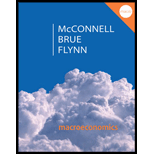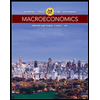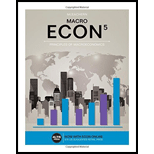
Subpart (a):
Effect of transactions.
Subpart (a):
Explanation of Solution
The effect of the transactions a, b, c on the consolidated
Column (a) also answers the transaction (d): Commercial banks increase their reserves after the Fed increases the interest rate and pays reserves.
|
Consolidated Balance Sheet: All Commercial Banks (in $ billions) | ||||
| (a) | (b) | (c) | ||
| Assets: | ||||
| Reserves | $30 | 32 | 31 | 30 |
| Securities | 60 | 58 | 60 | 60 |
| Loans | 60 | 60 | 60 | 60 |
| Liabilities and Net Worth: | ||||
| Checkable deposits | $150 | 150 | 150 | 150 |
| Loans from Federal Reserve Banks | 3 | 3 | 4 | 3 |
|
Consolidated Balance Sheet: 12 Federal Reserve Banks (in $ billions) | ||||
| (a) | (b) | (c) | ||
| Assets: | ||||
| Securities | $60 | 62 | 60 | 60 |
| Loans to Commercial Banks | 3 | 3 | 4 | 3 |
| Liabilities and Net Worth: | ||||
| Reserves of Commercial Banks | $30 | 32 | 31 | 30 |
| Treasury deposits | 3 | 3 | 3 | 3 |
| Federal Reserve Notes | $27 | 27 | 27 | 27 |
Assume the reserve ratio is 20%.
Suppose Fed purchases $2 billion worth of securities. This would increase commercial bank reserves by $2 billion (from $30 billion to $32 billion) and reduce securities by $2 billion (from $60 billion to $ 58 billion). This responds to the direct and immediate effect to the consolidated balance sheet.
With checkable deposits of $150 billion,
Concept Introduction:
Reserve Ratio: it is the ratio or percentage of deposit that banks must hold in liquid form.
Money Supply: It is the total money in circulation in the economy. It involves currency notes, deposits and other forms of liquid asset.
Money Multiplier: It is the ratio of reserves to the total amount of reserves in the banking system. It is the amount that bank generates or creates with each unit of reserves.
Open Market Operation (OMO): It is the monetary control mechanism employed which involves buying and selling of government securities in the open market to routine (expand or contract) the amount of money in the banking system.
Subpart (b):
Effect of transactions.
Subpart (b):
Explanation of Solution
Suppose the commercial banks borrow $1 billion from the Fed at the discount rate. This would increase commercial bank reserves by $1 billion (from $30 billion to $31 billion) in the asset side of the commercial bank and also would increase loans from Fed to $4billion (from $3 billion) in the liabilities side. This responds to the direct and immediate effect to the consolidated balance sheet.
Now, the excess reserve is $1 billion
Concept Introduction:
Reserve Ratio: it is the ratio or percentage of deposit that banks must hold in liquid form.
Money Supply: It is the total money in circulation in the economy. It involves currency notes, deposits and other forms of liquid asset.
Money Multiplier: It is the ratio of reserves to the total amount of reserves in the banking system. It is the amount that bank generates or creates with each unit of reserves.
Open Market Operation (OMO): It is the monetary control mechanism employed which involves buying and selling of government securities in the open market to routine (expand or contract) the amount of money in the banking system.
Subpart(c):
Effect of transactions.
Subpart(c):
Explanation of Solution
There is no immediate effect on the consolidated balance sheet due to the change in the reserve ratio. But in the longer term, when the reserve ratio decreases from 20% to say, 18%; the
Concept Introduction:
Reserve Ratio: it is the ratio or percentage of deposit that banks must hold in liquid form.
Money Supply: It is the total money in circulation in the economy. It involves currency notes, deposits and other forms of liquid asset.
Money Multiplier: It is the ratio of reserves to the total amount of reserves in the banking system. It is the amount that bank generates or creates with each unit of reserves.
Open Market Operation (OMO): It is the monetary control mechanism employed which involves buying and selling of government securities in the open market to routine (expand or contract) the amount of money in the banking system.
Subpart (d):
Effect of transactions.
Subpart (d):
Explanation of Solution
Commercial banks increase their reserves after the Fed increases the interest rate that it pays on reserves can be depicted by Columns A it shows that the increase in reserves came from selling securities. Column B also shows increase in reserves but it came from loans from the Federal Reserve Banks and it is unlikely that Fed would lend at an interest rate lower than it pays commercial banks for the reserve. When the Fed increases the interest rate it pays on reserve, the commercial bank increases reserves by decreasing loan to its customers.
Concept Introduction:
Reserve Ratio: it is the ratio or percentage of deposit that banks must hold in liquid form.
Money Supply: It is the total money in circulation in the economy. It involves currency notes, deposits and other forms of liquid asset.
Money Multiplier: It is the ratio of reserves to the total amount of reserves in the banking system. It is the amount that bank generates or creates with each unit of reserves.
Open Market Operation (OMO): It is the monetary control mechanism employed which involves buying and selling of government securities in the open market to routine (expand or contract) the amount of money in the banking system.
Want to see more full solutions like this?
Chapter 16 Solutions
Macroeconomics: Principles, Problems, & Policies
- Identify the two curves shown on the graph, and explain their upward and downward slopes. Why does curve Aintersect the horizontal axis? What is the significance of quantity d? What does erepresent? How would the optimal quantity of information change if the marginal benefit of information increased—that is, if the marginal benefit curve shifted upward?arrow_forward6. Rent seeking The following graph shows the demand, marginal revenue, and marginal cost curves for a single-price monopolist that produces a drug that helps relieve arthritis pain. Place the grey point (star symbol) in the appropriate location on the graph to indicate the monopoly outcome such that the dashed lines reveal the profit-maximizing price and quantity of a single-price monopolist. Then, use the green rectangle (triangle symbols) to show the profits earned by the monopolist. 18 200 20 16 16 14 PRICE (Dollars per dose) 12 10 10 8 4 2 MC = ATC MR Demand 0 0 5 10 15 20 25 30 35 40 45 50 QUANTITY (Millions of doses per year) Monopoly Outcome Monopoly Profits Suppose that should the patent on this particular drug expire, the market would become perfectly competitive, with new firms immediately entering the market with essentially identical products. Further suppose that in this case the original firm will hire lobbyists and make donations to several key politicians to extend its…arrow_forwardConsider a call option on a stock that does not pay dividends. The stock price is $100 per share, and the risk-free interest rate is 10%. The call strike is $100 (at the money). The stock moves randomly with u=2 and d=0.5. 1. Write the system of equations to replicate the option using A shares and B bonds. 2. Solve the system of equations and determine the number of shares and the number of bonds needed to replicate the option. Show your answer with 4 decimal places (x.xxxx); do not round intermediate calculations. This is easy to do in Excel. A = B = 3. Use A shares and B bonds from the prior question to calculate the premium on the option. Again, do not round intermediate calculations and show your answer with 4 decimal places. Call premium =arrow_forward
- Answer these questions using replication or the risk neutral probability. Both methods will produce the same answer. Show your work to receive credit. 6. What is the premium of a call with a higher strike. Show your work to receive credit; do not round intermediate calculations. S0 = $100, u=2, d=0.5, r=10%, strike=$150arrow_forwardAnswer these questions using replication or the risk neutral probability. Both methods will produce the same answer.arrow_forwardProblem 2: At a raffle, 2000 tickets are sold at $5 each for five prizes of $2000, $1000, $500, $250, and $100. You buy one ticket. What is the expected value of your gain? 1. Find the gain for each prize. 2. Write a probability distribution for the possible gains. 3. Find the expected value. 4. Interpret the results.arrow_forward
- This activity focuses on developing direct and supported opinions using various sources of information on the importance of the following topics: non-renewable and renewable energies, economic factors and obstacles that can affect the relationship between international trade and economic growth, devaluation of the currency in countries, and the imbalance of economic equity. In this context, it is essential that, when studying and developing these topics, students understand the concepts of the value of currencies and that leads to devaluation, non-renewable and renewable energy resources, economic development and obstacles, distribution of wealth, economic growth and external and internal constraints, and about international trade as a growth factor. Thus, the objectives that are intended to be achieved are the following: Acquire knowledge about the concepts mentioned above. Determine relationships between economic growth and international trade. Understand what some limitations that…arrow_forwardConsider a firm facing conventional production technology. The short run Production Function has a small range of increasing marginal product (increasing marginal returns) and then is subject to the Law of Diminishing Marginal Product (diminishing marginal returns). A. Putting quantity on the horizontal axis and dollars on the vertical axis, depict three important curves: Fixed Cost (FC), Variable Cost (VC), and Total Cost (TC). (Note that we are not asking you to depict average cost functions!) B. Please clearly indicate on this graph the range of quantities where the firm is experiencing (1) increasing marginal product and (2) diminishing marginal product. C. In a few sentences, please justify why you've made this specific classification of increasing/diminishing marginal product in part (b).arrow_forwardplease answer the following questions: What is money, and why does anyone want it? Explain the concept of the opportunity cost of holding money . Explain why an increase in U.S. interest rates relative to UK interest rates would affect the U.S.-UK exchange rate. Suppose that a person’s wealth is $50,000 and that her yearlyincome is $60,000. Also suppose that her money demand functionis given by Md = $Y10.35 - i2Derive the demand for bonds. Suppose the interest rate increases by 10 percentage points. What is the effect on her demand for bonds?b. What are the effects of an increase in income on her demand for money and her demand for bonds? Explain in wordsarrow_forward
- Driving Quiz X My Course G city place w x D2L Login - Univ X D2L Login - Univ x D2L Login - U acmillanlearning.com/ihub/assessment/f188d950-dd73-11e0-9572-0800200c9a66/4db68a5e-69bb-4767-8d6c-a12d +1687 pts /1800 © Macmillan Learning Question 6 of 18 > The graph shows the average total cost (ATC) curve, the marginal cost (MC) curve, the average variable cost (AVC) curve, and the marginal revenue (MR) curve (which is also the market price) for a perfectly competitive firm that produces terrible towels. Answer the three questions, assuming that the firm is profit-maximizing and does not shut down in the short run. What is the firm's total revenue? S What is the firm's total cost? $ What is the firm's profit? (Enter a negative number for a loss.) $ Price $320 $300 $200 $150 205 260 336 365 Quantity MC ATC AVC MR=Parrow_forward1. Suppose that the two nations face the following benefits of pollution, B, and costs of abatement, C: BN = 10, Bs = 7; CN = 5, Cs = 4. Further assume that if the nation chooses to abate pollution, it still receives the benefits of pollution but now must pay the cost of abatement as well. a. Identify the payoffs that accrue to each nation under the four different possible outcomes of the game and present these payoffs in the normal form of the game. b. Recall that the term dominant strategy defines the condition that a player in a game would prefer to play that strategy (in this case either pollute or abate) regardless of the strategy chosen by the other player in the game. Does either nation have a dominant strategy in this game? If so, what is it? c. Identify the Nash equilibria, or non-cooperative equilibria, of this game.arrow_forwardagrody calming Inted 001 and me 2. A homeowner is concerned about the various air pollutants (e.g., benzene and methane) released in her house when she cooks with natural gas. She is considering replacing her gas oven and stove with an electric stove comprising an induction cooktop and convection oven. The new appliance costs $900 to purchase and install. Capping the old gas line costs an additional $150 (a one-time fee). The old line must be inspected for leaks each year after capping, at a cost of $35 for each inspection. a. If the homeowner plans to remain in the house for four more years and the discount rate is 4%, what is the minimum present value of the benefits that the homeowner would need to experience for this purchase to be justified based on its private net sub present value? b. While trying to understand how she might express the value of reduced exposure to indoor air pollutants in dollar terms, the homeowner consulted the EPA website and found estimates provided by…arrow_forward
 Macroeconomics: Private and Public Choice (MindTa...EconomicsISBN:9781305506756Author:James D. Gwartney, Richard L. Stroup, Russell S. Sobel, David A. MacphersonPublisher:Cengage Learning
Macroeconomics: Private and Public Choice (MindTa...EconomicsISBN:9781305506756Author:James D. Gwartney, Richard L. Stroup, Russell S. Sobel, David A. MacphersonPublisher:Cengage Learning Economics: Private and Public Choice (MindTap Cou...EconomicsISBN:9781305506725Author:James D. Gwartney, Richard L. Stroup, Russell S. Sobel, David A. MacphersonPublisher:Cengage Learning
Economics: Private and Public Choice (MindTap Cou...EconomicsISBN:9781305506725Author:James D. Gwartney, Richard L. Stroup, Russell S. Sobel, David A. MacphersonPublisher:Cengage Learning
 Essentials of Economics (MindTap Course List)EconomicsISBN:9781337091992Author:N. Gregory MankiwPublisher:Cengage Learning
Essentials of Economics (MindTap Course List)EconomicsISBN:9781337091992Author:N. Gregory MankiwPublisher:Cengage Learning Brief Principles of Macroeconomics (MindTap Cours...EconomicsISBN:9781337091985Author:N. Gregory MankiwPublisher:Cengage Learning
Brief Principles of Macroeconomics (MindTap Cours...EconomicsISBN:9781337091985Author:N. Gregory MankiwPublisher:Cengage Learning Principles of Economics (MindTap Course List)EconomicsISBN:9781305585126Author:N. Gregory MankiwPublisher:Cengage Learning
Principles of Economics (MindTap Course List)EconomicsISBN:9781305585126Author:N. Gregory MankiwPublisher:Cengage Learning





